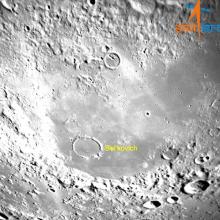Listen to today's episode of StarDate on the web the same day it airs in high-quality streaming audio without any extra ads or announcements. Choose a $8 one-month pass, or listen every day for a year for just $30.
You are here
Moon and Jupiter
The planet Jupiter huddles below the Moon at first light tomorrow. It looks like a brilliant star. But it’s really the solar system’s largest planet — a ball of gas about 11 times the diameter of Earth.
A quarter of a century ago, Jupiter was bombarded by the fragments of a shattered comet. The impacts were visible to telescopes on Earth. And the scars of the impacts remained visible for months.
A telescope has been watching impacts on the Moon as well. But none of them has been anywhere close to the magnitude of those on Jupiter.
The project is conducted by the European Space Agency. It uses a 48-inch telescope in Greece to record flashes of light on the dark portion of the lunar disk — the part where it’s nighttime. The project began in March of 2017, and recently was extended through January of 2021.
The flashes are produced by small asteroids — chunks of rock that orbit the Sun. Each flash is visible for only a fraction of a second. And each gouges a small crater on the lunar surface — a pit that can remain for billions of years.
From the number of flashes recorded so far, scientists estimate that there should be a couple of impacts across the entire Moon every hour.
Earth gets pelted by even more space rocks. Most of them burn up in the atmosphere. But the observations of the lunar impacts should help scientists determine the risks from impacts by bigger space rocks — ones that could harm our fragile planet.
Script by Damond Benningfield






